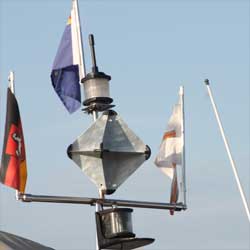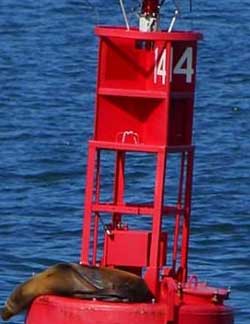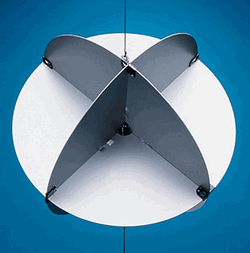
What is Radar?
Radar is a means of detecting and tracking the motion of objects using reflected radio waves. Radar uses electromagnetic waves at less than about 1012 Hz, to detect objects position, direction of travel and speed. It is widely used in marine and other environments including aviation, traffic control, and autonomous vehicles.
RADAR is an acronym for RAdio Detection And Ranging.
Radar signals are best reflected by materials of which conduct electricity well—like most metals, by seawater and by wet ground. Small crafts, particularly wood or fiberglass boats are difficult to detect and for this reason they are often equipped with radar reflectors.
How Does Radar Work?
A Radar is an instrument which transmits pulses of electromagnetic waves using an antenna/transmitter. When these pulses reach a reflective object, the pulse is either absorbed, transmitted and reflected. The reflection or echo is detected by the antenna/receiver of the radar and processed so it can be displayed onto a screen.
The antenna is often used both for sending the pulse and for receiving it (duplex antenna). The pulse is transmitted and the antenna switches to receiving mode, then back to transmission mode and so on.
Most antennas rotate or scan back and forth to listen to a larger slice. This motion also allows the radar to produce a more 3-d image.
When a reflected signal is detected by the antenna, it is amplified, doctored to remove noise and distortion and displayed on a visual screen. HD mostly refers to how the received signal is treated and improved. HD digital radar are replacing the non digital radar.
How does Radar measure Distance?
Electromagnetic radiation travels at a constant speed and in a straight line, (the effect of weather and atmosphere are negligible). It travels at the speed of light: 300,000 km. per second or 186000 miles per second. The radar pulse and echo are timed and the distance calculated from this. Since the pulse must travel to the object and back the calculated distance is divided by 2.
Radar Blind Spot
Because the antenna is used to alternately transmit then receive the signal, it must switch from transmission to reception mode (using a duplexing switch). There is a short period of time in which the antenna is switching to receiving and cannot yet listen. If an object is very close and the reflected signal is received while the antenna is switching and not yet receiving, the signal will not be registered and the object will not be "seen". The target is eclipsed.
This blind spot can be in the order of 150 Meters. This varies according to the frequency of the wave, and the type of switch used. This is significant for small boat navigation particularly in crowded waters.
Calculating the Speed of Objects
The speed of the object is calculated using the Doppler effect: the frequency of an object approaching the receiver will be greater than the original signal that was sent out. From this shift the actual velocity can be calculated. if the object is moving away from the radar unit, the received frequency is less. If the object is not moving relative to the radar, the received signal will have the same frequency as the transmitted signal.
Some Technical Details on Radar used by Pleasure Boats
Frequency of Radar pulse used for pleasure boats is in the range of 8-12 GHz. This is the I/J Band. For more detail on radar frequency Radar Tutorial has a good page.
As I was looking at the various models currently on sale, the chosen frequency was 9.4 KHz.
Various frequency have been tried and are used in other applications. The lower frequency can be more powerful but less accurate. The higher frequency can be extremely accurate at a smaller distance but are sensitive to atmospheric absorption. Very high frequency radar is used where long distance viewing is not required and can actually be a distraction, such as in automatic parking systems in cars.
Low-frequency radar uses frequencies lower than 1 GHz such as L-band, UHF, VHF, and HF. The more common radar bands range from 2 GHz and up. The maximum radar frequency is 40 GHz. The radar image returned depends on the radar transmitted frequency. At 900 MHz or less, the target radar image is very large, but the increased radar cross section means that there is much more noise, such as clouds and rain. Because of this a much higher frequency is more useful.
Distance which can be scanned is limited by the curvature of the earth. Radar is usually line of sight.
Some Radars operate in the 3-30 MHz band. These are over-the-horizon radars. Signals in that range can reflect off the ionosphere. These are specialized radar applications.
Manufacturers claim ranges of 48-64 nm. approx: 60-100 km. Placement of the unit will have a significant effect of how far it can see. The higher the radar placement the further it can see.
Another factor in the ability of radar to detect objects is the strength of the signal. Other factors being constant, a stronger signal will produce a stronger reflection.
There are some disadvantages to very strong Radar signals. More noise is produced by strong signals. Birds, wake and waves all combine to complicate the reading. Since the strong output create some radiation there is also a health issue. For this reason Radar is installed above where people stay.
In commonly offered models the antenna output will range between 2-6 KW. Some very low output new models are offered but there were no details as to comparison of efficiency and accuracy.
Most radar unit offered rotate at about 20-36 rpm and are often housed in an enclosed dome, a radome. This rotation allows the radar to see a larger slice than the small 2-5 degrees it scans on each pulse.
Radar sends a pulse that is 2-5 degrees on the horizontal and 16-25 degrees in the vertical. Various models have different sized wedges. The smaller the wedge the stronger the signal. This is similar to a powerful narrow spotlight vs a flood light. Both use the same amount of power but have a more or less concentrated beam.
What is HD radar
It is a poorly defined term that refers to how the signal is analyzed and treated after it is received.
In the past Radar was analog rather than digital and options to remove noise and amplify the signal were more limited
With the development of better computers, and improved techniques for treating the received signal, significant improvements have been seen. Noise reduction, multi-target displays, longer range, split screen display, always improving colour monitors are becoming available. More money will buy better software and features such as automatic identification of spotted items and superimposition of charts. Integration with other systems also come with a higher price.
What is the Cost of Radar?
Costs vary enormously. Low end systems can be as inexpensive as $1000, High end can set you back 10,000 or more. Boat stuff rarely has an upper limit!! Often the Radar is sold separately from the display which might serve other instruments such as plotter, gps, depth sounder etc.
How is radar reflected?
Figuring out reflections of radar signals is not simple. A whole branch of science is devoted to this and from this research Stealth technology has been developed.
Here is an article on how Stealth Bombers avoid Radar Detection it's an interesting read.
After leaving the transmitter the radio wave is propagated (at light-speed) in a widening beam. When it hits an object several things happen. Some of the beam is absorbed and some is transmitted. Some of the pulse gets reflected. Depending on the shape of the object the reflection can be be scattered through a wide angle. This is the case for roundish objects. Flat objects will reflect better but not necessarily back towards the antenna.
By rotating the antenna a larger and better area can be scanned, improving the received signals.
The received signal is much less powerful than the original transmitted radar radio pulse. The more powerful the original signal the more powerful the echo reflected back. The more sensitive the receiver, the better the received signal.
Not all substances reflect Radar equally well. Electrical conducting materials such as metals are better than insulators such as wood or fiberglass. Carbon fiber is better than Kevlar or fiberglass. Flat surfaces reflect better than curved surfaces.

What are Radar Reflectors?
Photo by Bin im Garten
Wood and fiberglass boats are not very good radar reflectors and tend to disappear. Even if small craft have materials that should reflect radar, it is often located quite low or even below the water line making it more difficult to see. Motors should reflect but because they are low they tend to not. Round masts even if metal tend to scatter radar signal and not provide good echos. In order to be more visible to radar small boats often install radar reflectors. These are often simple metallic foil with blades placed at right angles to maximize the reflection of radar signals and increase visibility.
In choosing a radar reflector larger is better. It should also be installed as high as possible.

Left: San Francisco Bay buoy with radar reflector (and sea lion).

Right: Davis Echomaster Radar Reflector (link to website at the left side bar) provides sharp corners to help reflect the Radar Echo.
For more information and lots of links to Radar Reflector suppliers check out the Safety-Marine" has a page on radar reflectors
My left side links have interesting articles on radar reflector experiments and reports.
The manner and amount that an object reflects or scatters radio waves is called its radar cross section.
What are Radar Enhancers?
A more effective way of appearing on radar is using a RTE, Radar Target Enhancer. Radar reflectors passively reflect received signals without any enhancement. By the time the receiving ship gets the signal it can be very weak. Radar enhancers improve the signal.
When a radar signal is received, it is electronically enhanced and amplified and sent back. This greatly increases the chances of being seen.
Here is a link to Echomax who produces a radar target enhancer. Sea Me is another brand.
email me if you find mistakes, I'll fix them and we'll all benefit: Christine
Radar
Defender sells many radar brands for boatsPanbo Marine Electronics Blog
Davis Echomaster Radar Reflector
Radar Reflector Comparison from US Sailing organisation.
Radar Absorbing Materials This is a PDF on a Paper written on RAM. Technical but not unreadable.
Ocean Navigator article about radar and how it reacts to various conditions and materials.
Radar Reflector on Kayaks a comprehensive article by Maine Sea Grant Extension
Duckworks Magazine article on making a passive radar reflector
My Tanzer 22 page
Installing radar on a small boat Article by Soundings online magazine
Small Print
This information is for general knowledge. IF you are shopping for radar consult a knowledgeable dealer. I made mistakes sometimes! The links were current when I put them up but the internet changes quickly, and I'm a slow gal. Let me know if you find a dead link.